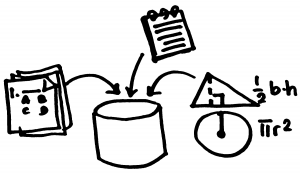All Content In One Place
| All Content In One Place | |
| Contributors | |
|---|---|
| Last modification | July 6, 2015 |
| Source | {{{source}}} |
| Pattern formats | OPR Alexandrian |
| Usability | |
| Learning domain | General |
| Stakeholders | Teachers Students |
| Confidence | |
| Evaluation | PLoP 2015 writing workshop Talk:ASSISTments |
| Application | ASSISTments |
| Applied evaluation | ASSISTments |
If students lose focus when they need to switch from the online learning interface to their textbook while answering exercises, then copy all content from the textbook into the online learning interface.
Context
Students are asked to answer problems in class or at home in an online learning system. Teachers have control over the content and presentation of each problem in the online learning system.
Problem
Students become bored or disengaged when asked to split their attention across multiple resources to solve a problem.
Solution
Replace textbook references in ASSISTments with actual textbook content.
Forces
- Accessibility. Students may lack access to resources used in the problem (e.g., forgetting to bring their textbook, finding internet access, having access to a computer)
- Split-attention effect. Unnecessary processing of information imposes a cognitive load that interferes with learning. High cognitive load impairs performance, which could increase the difficulty of a learning task (Sweller, 2004[1]).
- Affect. When students experience too much difficulty or get stuck in trying to solve a problem, they are likely to disengage from the activity (D’Mello and Graesser 2012[2]).
Consequences
Benefits
- Math problems that teachers assign to students will always display the problem content in ASSISTments.
- Students do not need to have their books to answer their homework or activity in ASSISTments.
- Students can work on their assignments even when they forget their books
- Students do not need to switch between their textbook and ASSISTments.
- May decrease boredom and gaming.
Liabilities
- It is difficult to encode math textbook problems into ASSISTments.
Example
When a teacher creates a math problem, he/she should copy the math problem into ASSISTments instead of placing a reference to the textbook he/she is using for class. This way, when students forget their books, they can still do their assignment. When students answer the math problem, they can focus more on the activity by reading the problem directly from ASSISTments instead of switching back and forth to get the textbook reference, to solve the problem, and to submit their answer to ASSISTments.
Evidence
Literature
Task switching usually results in slower response times compared to performing a single task and error-rate is usually higher after the switch [3]. Some of the switch cost sources identified include: time taken by control operations, transient task-set inertia, associative retrieval, or a mix of the three.
Data
Analysis of ASSISTments' data showed correlation between boredom and gaming, and math problems that required students to refer to their textbook to see the actual question.
Related patterns
This uses the same concept as Keep It Simple[1]. Using a single source for instruction makes math problems easier to understand.
References
- ↑ Sweller, J. (2004). Instructional design consequences of an analogy between evolution by natural selection and human cognitive architecture. Instructional science, 32(1-2), 9-31.
- ↑ D’Mello, S., & Graesser, A. (2012). Dynamics of affective states during complex learning. Learning and Instruction, 22(2), 145-157.
- ↑ Monsell, S. (2003). Task switching. Trends in cognitive sciences, 7(3), 134-140.
